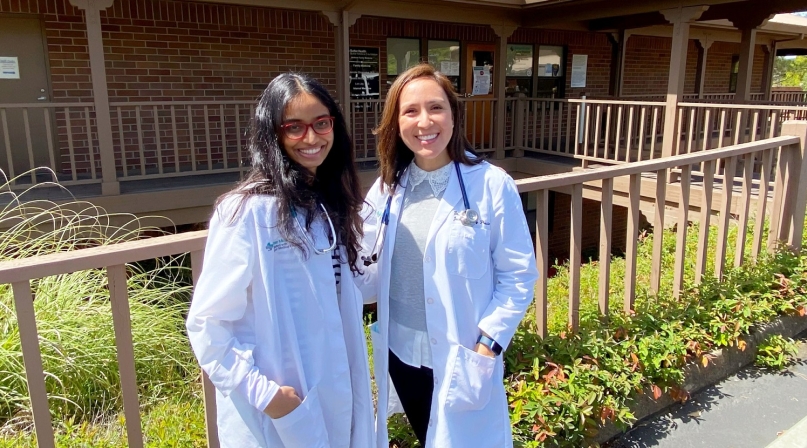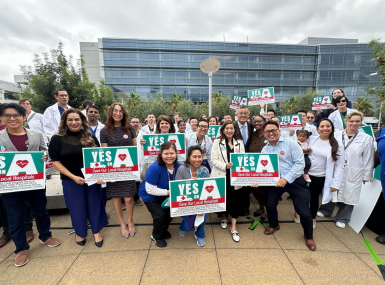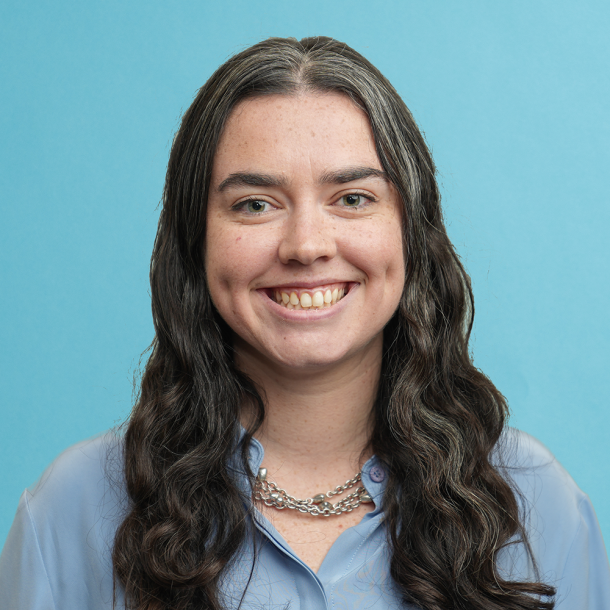Medical programs send budding doctors to rural county ‘healthcare deserts’

Key Takeaways
Amid a growing urban-rural divide in health care, hospitals and medical schools are creating programming to attract young talent and help rural counties bridge the physician gap. While the number of primary care physicians has increased significantly in the past decade, more young medical professionals are establishing roots in urban areas, classifying 82% of rural counties as medically underserved regions, according to a 2020 study published by the American Medical Association.
The Family Medicine Rural Residency Program is a three-year program — the first year spent in Sacramento and the last two in rural Amador County — where residents work inpatient and emergency medicine rotations at Sutter Amador Hospital, which serves over 40,000 people and is the only hospital in the county. The program, which launched in 2021, currently has six residents, including Jacob Frey, who graduated from the David Geffen School of Medicine at UCLA and was raised in rural Calaveras County, which neighbors Amador County.
“The challenges that you see inside of a rural community — as far as lack of health care and the absence of a lot of infrastructure to handle a lot of the basic needs that these people have — going into medicine, I absolutely wanted to deliver health care to an area that is in need and I wanted to be able to serve specifically my community that I live in,” Frey said. “I didn’t want to be a doctor outside of the community and treating people in a different area; I wanted to be part of that community.
“I think it’s really important to understand the challenges that those rural communities face by being a part of it and experiencing it firsthand, and having grown up in it, just sort of knowing what those are and just coming back after being able to have a little bit of life experience and being able to contribute back to my community in a positive way.”
Family medicine residents who spent 50% or more of their training time in rural settings were at least five times more likely than residents with no rural training to practice in a rural setting, according to a 2022 study published in the Journal of Graduate Medical Education.
The University of Washington School of Medicine’s Rural Underserved Opportunities Program (RUOP) serves underserved rural counties and boroughs across Washington, Wyoming, Alaska, Montana and Idaho. It is aiming to start that pipeline even earlier, offering a four-week rotation for students between their first and second years of medical school.
“People are imprinted upon early, so if I expose a medical student early on to emergency room care, they’re more likely to do emergency room medicine,” said Dr. John McCarthy, assistant dean of the university’s Office of Rural Programs. “If I expose them to a great mentor in obstetrics early on, they’re more likely to do obstetrics.”
Studies have found that medical professionals who were raised in rural areas are far more likely to practice in rural areas than their urban peers; however, students from rural backgrounds make up under 5% of the incoming medical student body.
“People from rural areas are more likely to go back to rural areas, but there’s a lot more people from urban areas that go into medical school,” McCarthy said. “So, percentage wise, more rural people will end up going rural, but total number wise, because there are more urban players in medicine, there are actually more urban players going rural.”
Recognizing this, Amador County is aiming to both create space for medical professionals from rural backgrounds and mark a different path for those from urban areas.
The Sutter Health Family Medicine Residency, which the rural program falls under, has started an Underrepresented in Medicine scholarship for fourth-year medical students, many of whom are from other parts of the country. An additional scholarship through the rural track is in the works, with the hope that people will return after they graduate, according to Dr. Robert Hartmann, an Amador County internal medicine specialist who is a core faculty member of the residency program.
“To use an example, you’ve got a med student in Philadelphia who wants to do a fourth-year, one-month rotation, but it’s on the West Coast, and that can be pretty pricey — you’ve got to find a place to live, get transportation once you get there,” Hartmann said. “… Looking at it from an equity issue standpoint, we’re also this year planning to establish an Underrepresented in Medicine/Rural scholarship to offset costs that they would have in getting here and doing a month rotation with us in a rural area and learning more about us.”
Hartmann said the Family Medicine Rural Residency Program has brought “vibrancy” to the medical system in Amador County.
“A woman stopped me the other day and said, ‘My 16-year-old came in to see Dr. Ganta [a resident] and has seen her a couple of times and she is so happy, she finally has a young physician that she can relate to,’” Hartmann said.
“We get tons of positive feedback from the fact that the residents are seeing patients and are in the community,” he noted. “They’ll see [residents] in the hospital when they’re doing inpatient rotations, and then when they’re discharged, they’ll see them in the continuity clinic and it gives a sense to the patients of ‘somebody’s really caring about me, they’re really following up on these things.’
“One of the things we’re trying to inculcate in the young learners is ‘Listen to the patient, take care of the patient,’ and people in the community really appreciate that.”
Frey said the most rewarding aspect of spending his residency in Amador County has been the sense of “connectedness” with the community, which Hartmann echoed.
“We all need to have this sense of community,” Hartmann said.
“We’re in this for the community to get better health care and get more providers and help our rural community thrive because rural communities in the U.S. have really been kicked in the teeth a lot … they’ve really had difficulty sort of maintaining businesses and maintaining health care, and we want a good thriving community in our rural area, and that includes having a good hospital, that includes having good primary care, good specialty care and we’re just trying to be a part of that.”
Related News

CMS issues new guidance on Medicaid Community Engagement Requirements
On December 8, the Centers for Medicare & Medicaid Services (CMS) released a Medicaid and CHIP Services Informational Bulletin (CIB) directing states on how to implement the Medicaid community engagement requirements enacted under Section 71119 of the One Big Beautiful Bill Act legislation (Public Law 119-21), or H.R. 1.

California county sales tax measure backfills federal healthcare cuts
Santa Clara County, Calif. will raise an estimated $330 million each year from a sales tax to backfill lose Medicaid funding.

